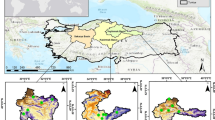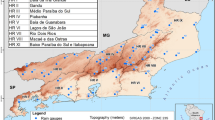Abstract
Under the influence of El Niño/Southern Oscillation (ENSO), the Southern Oscillation Index events, changes in precipitation intensity and duration thereon in both space and time in the Huai River basin, China, are investigated. Different behaviors of precipitation intensity and duration during different ENSO episodes were also analyzed, and significance of these changes was evaluated using Mann–Whitney U test method. Results of this study indicate that: (1) the north Huai River basin is dominated by decreasing precipitation, specifically in the Yi-Shu-Si River basin, and increasing precipitation in the south Huai River basin. Increasing number of annual maximum consecutive dry days, decreasing number of annual maximum consecutive wet days (MCD) and decreasing precipitation amount of annual maximum consecutive wet days (MCP) indicate a drying tendency in the northern parts of the Huai River basin, implying intensifying droughts. However, a wetting tendency is observed in the southeast parts of the Huai River basin as a result of increasing annual total precipitation amount and increasing MCD and MCP; (2) the influence of Eastern Pacific Warming (EPW), Central Pacific Warming (CPW) and Eastern Pacific Cooling (EPC) on heavy precipitation and rainstorms is evident. There is more significant influence of EPC on rainstorms. EPW and CPW cause a higher risk of flooding in the south Huai River basin, whereas EPC causes a higher risk of flooding in the north Huai River basin; (3) longer-lasting precipitation events are observed to be decreasing during the EPC and CPW periods, whereas occurrences of longer-lasting precipitation events are found to be increasing during the EPW period. This study is of practical value in planning and management of agricultural irrigation and water resources and helps understand the influence of ENSO events on precipitation regimes in the Huai River basin, China.













Similar content being viewed by others
References
Alan DZ, Justin S, Edwin PM, Bart N, Eric FW, Dennis PL (2003) Detection of intensification in global- and continental-scale hydrological cycles: temporal scale of evaluation. J Clim 16:535–547
Allan RP, Soden BJ (2008) Atmospheric warming and the amplification of precipitation extremes. Science 321(5895):1481–1484
Ashok K, Behera SK, Rao SA, Weng H, Yamagata T (2007) El Niño Modoki and its possible teleconnection. J Geophys Res 112:C11007
Ashok K, Tam C, Lee W (2009) ENSO Modoki impact on the Southern Hemisphere storm track activity during extended austral winter. Geophys Res Lett 36:L12705
Chen X, Hao Z, Devineni N, Lall U (2014) Climate information based streamflow and rainfall forecasts for Huai River basin using hierarchical Bayesian modeling. Hydrol Earth Syst Sci 18:1539–1548
Dore HIM (2005) Climate change and changes in global precipitation patterns: what do we know? Environ Int 31:1167–1181
Easterling DR, Meehl GA, Parmesan C, Changnon SA, Karl TR, Mearns LO (2000) Climate extremes: observations, modeling, and impacts. Science 289:2068–2074
Feng J, Chen W, Tam CY, Zhou W (2011) Different impacts of El Niño and El Niño Modoki on China rainfall in the decaying phases. Int J Climatol 31:2091–2101
Gao G, Chen DL, Xu C-Y, Simelton E (2007) Trend of estimated actual evapotranspiration over China during 1960–2002. J Geophys Res 112:D11120. doi:10.1029/2006JD008010
Gershunov A, Barnett TP (1998) ENSO influence on intraseasonal extreme rainfall and temperature frequencies in the contiguous United States: observations and model results. J Clim 11(7):1575–1586
Gershunov A, Cayan DR (2003) Heavy daily precipitation frequency over the contiguous United States: sources of climatic variability and seasonal predictability. J Clim 16(16):2752–2765
Grimm AM, Tedeschi RG (2009) ENSO and extreme rainfall events in South America. J Clim 22(7):1589–1609
Hollander M, Wolfe DA, Chicken E (2013) Nonparametric statistical methods, vol 751. Wiley, New York
Huang Y, Tian Q, Du L, Sun S (2013) Analysis of spatial–temporal variation of agricultural drought and its response to ENSO over the past 30 years in the Huang-Huai-Hai region, China. Terr, Atmos Ocean Sci 24(4):745–759
Huntington TG (2006) Evidence for intensification of the global water cycle: review and synthesis. J Hydrol 319:83–95
IPCC (2007) Climate change: fourth assessment report of the Intergovernmental Panel on Climate Change. Cambridge University Press, Cambridge
Kim HM, Webster PJ, Curry JA (2009) Impact of shifting patterns of Pacific Ocean warming on North Atlantic tropical cyclones. Science 325:77–80
Li Q, Yang S, Kousky VE, Higgins RW, Lau K-M, Xie P (2005) Features of cross-pacific climate shown in the variability of China and US precipitation. Int J Climatol 25:1675–1696
Lin AC, Wen L, Lu GH, Wu ZY, Zhang JY, Yang Y, Zhu YF, Tong LY (2006) Atmospheric-hydrological modeling of severe precipitation and floods in the Huaihe River basin, China. J Hydrol 330:249–259
Mann HB, Whitney DR (1947) On a test of whether one of two random variables is stochastically larger than the other. Ann Math Stat 18(1):50–60
Milly PCD, Wetherald RT, Dunne KA, Delworth TL (2002) Increasing risk of great floods in a changing climate. Nature 415:514–517
Mirza MMQ (2002) Global warming and changes in the probability of occurrence of floods in Bangladesh and implications. Glob Environ Change 12:127–138
Sen PK (1968) Estimates of the regression coefficient based on Kendall’s tau. J Am Stat As 63:1379–1389
Shabbar A, Barrie B, Madhav K (1997) Canadian precipitation patterns associated with the Southern Oscillation. J Clim 10:3016–3027
Smith TM, Reynolds RW, Peterson TC, Lawrimore J (2008) Improvements to NOAA’s historical merged land–ocean surface temperature analysis (1880–2006). J Clim 21:2283–2296
Sprent P, Smeeton NC (2007) Applied nonparametric statistical methods. CRC Press, Boca Raton
Svensson C (1999) Empirical orthogonal function analysis of daily rainfall in the upper reaches of the Huai River basin, China. Theor Appl Climatol 62:147–161
Theil H (1950) A rank invariant method for linear and polynomial regression analysis. Nederl Akad Wetensch Proc Ser A 53:386–392 (Part I), 521–525 (Part II), 1397–1412 (Part III)
Webster PJ, Magana VO, Palmer TN, Shukla J, Tomas RA, Yanai M, Yasunari T (1998) Monsoons: Processes, predictability, and the prospects for prediction. J Geophys Res 103(7):14451–14510
Weng H, Ashok K, Behera SK, Rao SA, Yamagata T (2007) Impacts of recent El Niño Modoki on dry/wet conditions in the Pacific rim during boreal summer. Clim Dyn. doi:10.1007/s00382-007-0234-0
Yan DH, Wu D, Huang R, Wang LN, Yang GY (2013) Drought evolution characteristics and precipitation intensity changes during alternating dry–wet changes in the Huang-Huai-Hai River basin. Hydrol Earth Syst Sci 17:2859–2871
Yang ZF, Cui BS, Liu JL (2005) Estimation methods of eco-environmental water requirements: case study. Sci China 48(8):1280–1292
Zhang RH, Sumi A, Kimoto M (1999) A diagnostic study of the impact of El Nino on the precipitation in China. Adv Atmos Sci 16(2):229–241
Zhang Q, Xu C-Y, Jiang T, Wu Y (2007) Possible influence of ENSO on annual maximum streamflow of the Yangtze River, China. J Hydrol 333:265–274
Zhang YY, Xia J, Liang T, Shao QX (2010) Impact of water projects on river flow regime and water quality in Huai River basin. Water Resour Manag 24:889–908
Zhang Q, Singh VP, Li J, Chen X (2011a) Analysis of the periods of maximum consecutive wet days in China. J Geophys Res 116:D23106. doi:10.1029/2011JD016088
Zhang Q, Xu C-Y, Chen YD, Ren LL (2011b) Comparison of evapotranspiration variations between the Yellow River and Pearl River basin, China. Stoch Environ Res Risk Assess 25(2):139–150
Zhang YY, Shao Q, Xia J, Bunn SE, Zuo Q (2011c) Changes of flow regimes and precipitation in Huai River basin in the last half century. Hydrol Process 25:246–257
Zhang Q, Singh VP, Li J, Jiang F, Bai Y (2012) Spatiotemporal variations of precipitation extremes in Xinjiang, China. J Hydrol 434–435:7–18
Zhang Q, Li JF, Singh VP, Xiao M (2013a) Spatio-temporal relations between temperature and precipitation regimes: implications for temperature-induced changes in the hydrological cycle. Glob Planet Change 111:57–76
Zhang Q, Li J, Singh VP, Xu C-Y, Deng J (2013b) Influence of ENSO on precipitation in the East River basin, South China. J Geophys Res 118(5):2207–2219
Zhao CS, Sun CL, Liu CM, Xia J, Yang G, Liu XM, Zhang D, Dong BE, Sobkowiak L (2014) Analysis of regional zoobenthos status in the Huai River basin, China using two new ecological niche clustering approaches. Ecohydrology 7:91–101
Zhou L, Xu J-G, Zhang M-D, Jiang J, Sun D (2013) Spatial–temporal variation of agriculture production efficiency under the background of grain production increase in the Huai River basin. Sci Geogr Sin 33(12):1476–1483 (in Chinese with English abstract)
Zou KH, Tuncali K, Silverman SG (2003) Correlation and simple linear regression. Radiology 227:617–628
Zubair L, Siriwardhana M, Chandimala J, Yahiya Z (2008) Predictability of Sri Lankan rainfall based on ENSO. Int J Climatol 28(1):91–101
Acknowledgments
This work is financially supported by the National Science Foundation for Distinguished Young Scholars of China (Grant No. 51425903), the Natural Foundation of Anhui Province (Grant No. 1508085MD65), and is fully supported by a grant from the Research Grants Council of the Hong Kong Special Administrative Region, China (Project No. CUHK441313). Detailed information such as data can be obtained by writing to the corresponding author at zhangq68@mail.sysu.edu.cn. Our cordial gratitude should be extended to the editor, Prof. Dr. T. S. Murty, and two reviewers for their professional comments and pertinent revision suggestions which are greatly helpful for further improvement of the quality of this manuscript.
Author information
Authors and Affiliations
Corresponding author
Rights and permissions
About this article
Cite this article
Wang, Y., Zhang, Q. & Singh, V.P. Spatiotemporal patterns of precipitation regimes in the Huai River basin, China, and possible relations with ENSO events. Nat Hazards 82, 2167–2185 (2016). https://doi.org/10.1007/s11069-016-2303-3
Received:
Accepted:
Published:
Issue Date:
DOI: https://doi.org/10.1007/s11069-016-2303-3




